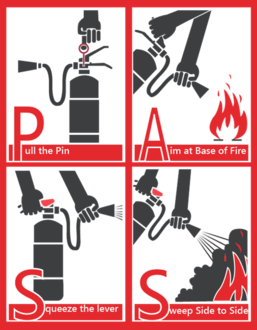
Fires in homes are most often caused by cooking accidents, smoking or the unsafe use of woodstoves or space heaters. The majority of house fires are 100% preventable. Fires pose a risk to homes, businesses and other buildings. In the event of a fire, evacuate the area and immediately call 9-1-1.
Illustrated Fire Preparation Guides
አማርኛ || 한국어 || عربى || ਪੰਜਾਬੀ || 繁體中文 || Русский || English || Español || فارسی || اردو || हिंदी || tiếng Việt || 日本語
Before a Fire
- Create and practice your home escape plan. Have at least two ways to escape from every room in your house.
- Install an ABC fire extinguisher in your home and teach each family member how to use it. If a fire is too large for you to extinguish, immediately get out of the house.
- Smoke alarms and carbon monoxide detectors should be installed on every level of the residence, outside bedrooms, at the top of open stairways and near (but not in) the kitchen.
- Test alarms monthly.
- Replace batteries yearly.
- Replace smoke alarms and CO detectors every 10 years.
- Store copies of important documents in a fire-proof container or box.
During a Fire
Alert others within the house and get out of the building. A fire can spread throughout a house in under five minutes.
- Leave immediately and call 9-1-1 as soon as it's safe to do so.
- Crawl low and stay under any possible smoke.
- Follow your home escape plan and use alternate escape routes if your nearest exit is blocked by fire.
- If you need to open a closed door, check for heat prior to opening it using the back of your hand on the top of the door and touching the doorknob.
- If the door feels hot or there is smoke coming from around the door, use an alternate route.
- If you open a door, open it slowly inspecting for the presence of fire.
- If you're unable to escape the building, stay where you are.
- Close the door and cover any vents or cracks with cloth or tape.
- Let 9-1-1 dispatch know where you are and, if possible, signal for help at the window with a flashlight or light-colored cloth.
- If your clothes catch fire, stop, drop, and roll.
Know How to Use a Fire Extinguisher
Knowing how to use a fire extinguisher is a key safety skill. Fire extinguishers are suitable to put out small fires. Several small extinguishers located throughout the house are more beneficial than one large one as your route to the extinguisher may be blocked. Key places to store a fire extinguisher include the kitchen, garage and one on every level of your home.
P.A.S.S. is a proven and effective method for putting out fires.
P = Pull the pin
A = Aim at the base of the flames
S = Squeeze the trigger
S = Sweep side to side until the fire is out
The three elements required in the right combination for a fire to occur are: a heat or ignition source, oxygen, and fuel. If the fire is or becomes too large, leave immediately and from a safe distance call 9-1-1.
After a Fire
- If you are insured, contact your insurance company for instructions on how to proceed.
- Save all receipts for any money spent related to the fire.
- Conduct an inventory of any damaged property and personal possessions.
- Do not re-enter the building until it has been deemed safe to do so.
- Do not attempt to turn any utilities back on, please contact your utility provider.
- Notify your mortgage company of the fire.
- Experiencing a fire can have a lasting and devastating effect. The American Red Cross has resources available to help you through your recovery process.
